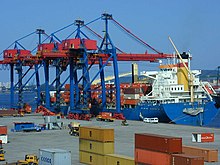Port of Santos
The Port of Santos is located in the city of Santos, state of São Paulo, Brazil. As of 2006, it is the busiest container port in Latin America.[1]
It possesses a wide variety of cargo handling terminals—solid and liquid bulk, containers, and general loads. It is Brazil's leading port in container traffic. The terrestrial access system to the port is made up by the Anchieta and Imigrantes highways and by the railroads operated by Ferroban and MRS.
It was once considered the "port of death" in the 19th century due to yellow fever, and ships often avoided docking at the wood plank port. The floods in the city's area provoked illnesses. [citation needed]

Today it is Latin America's largest port. Its structure is considered Brazil's most modern.
In the early 20th century, major overhauling and urbanization created the port's modern structure seen today, eliminating the risk of diseases and providing the port with modern, industrial-age infrastructure.
The location of the city of Santos was chosen at a convenient point for crossing the Serra do Mar mountain range, which is the main obstacle to access the interior. The first railway link from the port to the state capital São Paulo City, 79 km away, and the state's interior, was completed in 1864. This allowed for an easier transportation of the vast masses of migrant workers who headed to São Paulo and the state's numerous coffee farms. The main product exported by Santos until World War II was São Paulo state's huge coffee production, Brazil's largest. Today, coffee has become a smaller component of Brazil's exports and cars, machinery, orange juice, soybeans are now some of the port's main exports.
Millions of immigrants reached Brazil via the Port of Santos in the late 19th and early 20th centuries, proceeding to the country's interior by railway.
It is the world's 39th largest port in terms of container traffic and South America's largest.

